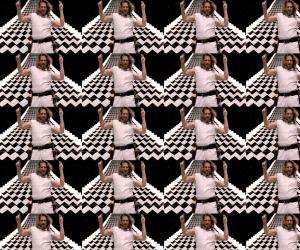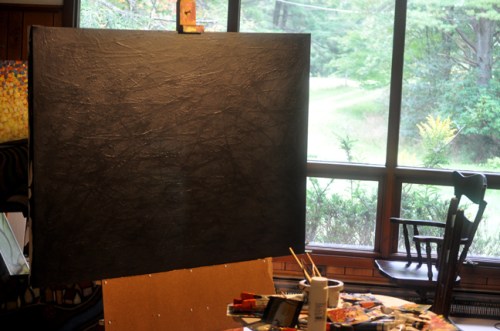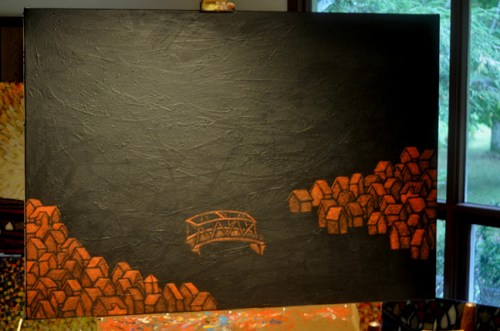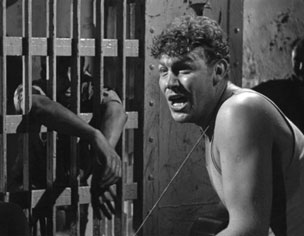 I’m at a point with this work in progress, a 42″ by 60″ canvas, where I have basically finished the underpainting which is the process of blocking in the composition. The next step for me is to start building up color throughout the piece, developing more depth from all the elements. In this case, I start by using a light application, again almost drybrush, of a yellowish paint. for this piece I’m using a yellow oxide.
I’m at a point with this work in progress, a 42″ by 60″ canvas, where I have basically finished the underpainting which is the process of blocking in the composition. The next step for me is to start building up color throughout the piece, developing more depth from all the elements. In this case, I start by using a light application, again almost drybrush, of a yellowish paint. for this piece I’m using a yellow oxide.
The thinly applied yellow allows me to see dimension yet still lets the darkness of the base’s black and the red of the underpainting show through. This is something that I feel is crucial to the feeling I’m trying to achieve. Again, I could easily go through and simply paint each structure with one pure color and save a ton of time but it would lose the effect I desire. Besides, it gives me more time to consider each subsequent move.
Now comes some red. I start with a few cross-strokes of a crimson in the sky then start applying some yellow strokes as well, just to start to give light the sky. I also start to lighten the path in all parts of the painting just to give some more depth. At this point, I’m also pondering if I should start working a bit on the waterway as it is such a large and crucial element in the lower half of the painting and it’s darkness at this point might alter how I proceed with other elements. After some thought, I decide against working on the waterway and move on to the roofs of the structures.
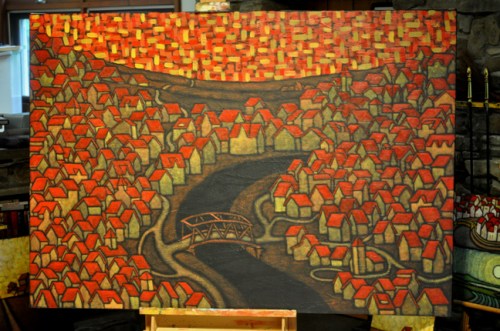 Again, I use a crimson red that is a bit darker which gives me a bit of leeway so that I can lighten roofs later as I see the need. I’m beginning to see more and more light in the piece at this point and can see areas where I want to concentrate in some of the next steps in the process. For instance, sides of the houses that will be a sort of focal points through the piece. I’m reminded also at this juncture of how the roofs of the village act as little pointers or arrows that move the eye upward in the picture. I do this with other elements as well, in may of my paintings, everything pushing the eye toward the center of the painting. It didn’t start as a conscious effort but I became aware that I was doing this years ago and have been doing this subconsciously, albeit with an awareness, for years.
Again, I use a crimson red that is a bit darker which gives me a bit of leeway so that I can lighten roofs later as I see the need. I’m beginning to see more and more light in the piece at this point and can see areas where I want to concentrate in some of the next steps in the process. For instance, sides of the houses that will be a sort of focal points through the piece. I’m reminded also at this juncture of how the roofs of the village act as little pointers or arrows that move the eye upward in the picture. I do this with other elements as well, in may of my paintings, everything pushing the eye toward the center of the painting. It didn’t start as a conscious effort but I became aware that I was doing this years ago and have been doing this subconsciously, albeit with an awareness, for years.
I was a little apprehensive in showing how I paint in this style, afraid that it might take away some of the mystique of the final paintings, make it seem that the work was a pure product of process. But taking the time to write down how I proceed makes me realize that while there is a process it is the decisions that are made during the process that make it either work or not work. Intuition and a constant visual weighing of elements play huge roles in this decision making, which makes each piece unique beyond the process. These are things that I take for granted in my day to day existence in the studio, parts of the process that are below the surface and operating on a subconscious level but are perhaps the most important aspects of the process.
So, I’m on to the next step. Stay tuned…







